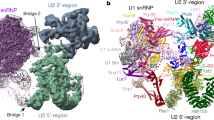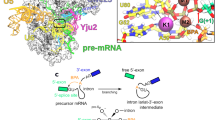Abstract
Introns are removed from nuclear messenger RNA precursors through two sequential phospho-transesterification reactions in a dynamic RNA–protein complex called the spliceosome1,2. But whether splicing is catalysed by small nuclear RNAs3,4 in the spliceosome is unresolved. As the spliceosome is a metalloenzyme5,6,7, it is important to determine whether snRNAs coordinate catalytic metals. Here we show that yeast U6 snRNA coordinates a metal ion that is required for the catalytic activity of the spliceosome. With Mg2+, U6 snRNA with a sulphur substitution for the pro-RP or pro-SP non-bridging phosphoryl oxygen of nucleotide U80 reconstitutes a fully assembled yet catalytically inactive spliceosome. Adding a thiophilic ion such as Mn2+ allows the first transesterification reaction to occur in the U6/sU80(SP)- but not the U6/sU80(RP)-reconstituted spliceosome. Mg2+ competitively inhibits the Mn2+-rescued reaction, indicating that the metal-binding site at U6/U80 exists in the wild-type spliceosome and that the site changes its metal requirement for activity in the SP spliceosome. Thus, U6 snRNA contributes to pre-messenger RNA splicing through metal-ion coordination, which is consistent with RNA catalysis by the spliceosome.
This is a preview of subscription content, access via your institution
Access options
Subscribe to this journal
Receive 51 print issues and online access
$199.00 per year
only $3.90 per issue
Buy this article
- Purchase on Springer Link
- Instant access to full article PDF
Prices may be subject to local taxes which are calculated during checkout




Similar content being viewed by others
References
Sharp, P. A. Split genes and RNA splicing. Cell 77, 805–815 (1994).
Guthrie, C. The spliceosome is a dynamic ribonucleoprotein machine. Harvey Lect. 90, 59–80 (1994).
Nilsen, T. W. in RNA Structure and Function (eds Simons, R. & Grunberg-Manago, M.) 279–307 (Cold Spring Harbor Laboratory Press, Cold Spring Harbor, 1998).
Collins, C. A. & Guthrie, C. The question remains: is the spliceosome a ribozyme? Nature Struct. Biol. 7, 850–854 (2000).
Steitz, T. A. & Steitz, J. A. A general two-metal-ion mechanism for catalytic RNA. Proc. Natl Acad. Sci. USA 90, 6498–6502 (1993).
Sontheimer, E. J., Sun, S. & Piccirilli, J. A. Metal ion catalysis during splicing of premessenger RNA. Nature 388, 801–805 (1997).
Gordon, P. M., Sontheimer, E. J. & Piccirilli, J. A. Metal ion catalysis during the exon-ligation step of nuclear pre-mRNA splicing: extending the parallels between the spliceosome and group II introns. RNA 6, 199–205 (2000).
Staley, J. P. & Guthrie, C. Mechanical devices of the spliceosome: motors, clocks, springs, and things. Cell 92, 315–326 (1998).
Pyle, A. M. Ribozymes: a distinct class of metalloenzymes. Science 261, 709–714 (1993).
Sigel, R. K. O., Song, B. & Sigel, H. Stabilities and structures of metal ion complexes of adenosine 5′-O-thiomonophosphate (AMPS2-) in comparison with those of its parent nucleotide (AMP2-) in aqueous solution. J. Am. Chem. Soc. 119, 744–755 (1997).
Fabrizio, P. & Abelson, J. Thiophosphates in yeast U6 snRNA specifically affect pre-mRNA splicing in vitro. Nucleic Acids Res. 20, 3659–3664 (1992).
Yu, Y. T., Maroney, P. A., Darzynkiwicz, E. & Nilsen, T. W. U6 snRNA function in nuclear pre-mRNA splicing: a phosphorothioate interference analysis of the U6 phosphate backbone. RNA 1, 46–54 (1995).
Brautigam, C. A. & Steitz, T. A. Structural principles for the inhibition of the 3′–5′ exonuclease activity of Escherichia coli DNA polymerase I by phosphorothioates. J. Mol. Biol. 277, 363–377 (1998).
Smith, J. S. & Nikonowicz, E. P. Phosphorothioate substitution can substantially alter RNA conformation. Biochemistry 39, 5642–5652 (2000).
Kim, C. H. & Abelson, J. Site-specific crosslinks of yeast U6 snRNA to the pre-mRNA near the 5′ splice site. RNA 2, 995–1010 (1996).
Kim, S. H. & Lin, R. J. Spliceosome activation by PRP2 ATPase prior to the first transesterification reaction of pre-mRNA splicing. Mol. Cell. Biol. 16, 6810–6819 (1996).
Basu, S. & Strobel, S. A. Thiophilic metal ion rescue of phosphorothioate interference within the Tetrahymena ribozyme P4-P6 domain. RNA 5, 1399–1407 (1999).
Moore, M. J. & Sharp, P. A. Evidence for two active sites in the spliceosome provided by stereochemistry of pre-mRNA splicing. Nature 365, 364–368 (1993).
Piccirilli, J. A., Vyle, J. S., Caruthers, M. H. & Cech, T. R. Metal ion catalysis in the Tetrahymena ribozyme reaction. Nature 361, 85–88 (1993).
Weinstein, L. B., Jones, B. C., Cosstick, R. & Cech, T. R. A second catalytic metal ion in group I ribozyme. Nature 388, 805–808 (1997).
Peracchi, A., Beigelman, L., Scott, E. C., Uhlenbeck, O. C. & Herschlag, D. Involvement of a specific metal ion in the transition of the hammerhead ribozyme to its catalytic conformation. J. Biol. Chem. 272, 26822–26826 (1997).
Murray, J. B. & Scott, W. G. Does a single metal ion bridge the A-9 and scissile phosphate groups in the catalytically active hammerhead ribozyme structure? J. Mol. Biol. 296, 33–41 (2000).
Christian, E. L. & Yarus, M. Metal coordination sites that contribute to structure and catalysis in the group I intron from Tetrahymena. Biochemistry 32, 4475–4480 (1993).
Christian, E. L., Kaye, N. M. & Harris, M. E. Helix P4 is a divalent metal ion binding site in the conserved core of the ribonuclease P ribozyme. RNA 6, 511–519 (2000).
Chanfreau, G. & Jacquier, A. Catalytic site components common to both splicing steps of a group II intron. Science 266, 1383–1387 (1994).
Madhani, H. D. & Guthrie, C. Randomization-selection analysis of snRNAs in vivo: evidence for a tertiary interaction in the spliceosome. Genes Dev. 8, 1071–1086 (1994).
Valadkhan, S. & Manley, J. L. A tertiary interaction detected in a human U2–U6 snRNA complex assembled in vitro resembles a genetically proven interaction in yeast. RNA 6, 206–219 (2000).
Boudvillain, M., de Lencastre, A. & Pyle, A. M. A tertiary interaction that links active-site domains to the 5′ splice site of a group II intron. Nature 406, 315–318 (2000).
Burgers, P. M. & Eckstein, F. Absolute configuration of the diastereomers of adenosine 5′-O-(1-thiotriphosphate): consequences for the stereochemistry of polymerization by DNA-dependent RNA polymerase from Escherichia coli. Proc. Natl Acad. Sci. USA 75, 4798–4800 (1978).
Moore, M. J. & Sharp, P. A. Site-specific modification of pre-mRNA: the 2′-hydroxyl groups at the splice sites. Science 256, 992–997 (1992).
Acknowledgements
We thank J. Abelson for U6 plasmids; D. McPheeters and D. Ryan for advice on RNA ligation procedure; and T. Nilsen, E. Sontheimer, D. McPheeters, J. Rossi, G. Edwalds-Gilbert and E. Silverman for critical reading of the manuscript. This work is supported by grants from NIH to J.T. and R.-J.L. The Molecular Dynamics phosphorimager was purchased with a core grant from NSF.
Author information
Authors and Affiliations
Corresponding author
Rights and permissions
About this article
Cite this article
Yean, SL., Wuenschell, G., Termini, J. et al. Metal-ion coordination by U6 small nuclear RNA contributes to catalysis in the spliceosome. Nature 408, 881–884 (2000). https://doi.org/10.1038/35048617
Received:
Accepted:
Issue Date:
DOI: https://doi.org/10.1038/35048617
This article is cited by
-
Quantum Spin Exchange Interactions to Accelerate the Redox Kinetics in Li–S Batteries
Nano-Micro Letters (2024)
-
Main-group metal elements as promising active centers for single-atom catalyst toward nitric oxide reduction reaction
npj 2D Materials and Applications (2022)
-
A single m6A modification in U6 snRNA diversifies exon sequence at the 5’ splice site
Nature Communications (2021)
-
Turning main-group element magnesium into a highly active electrocatalyst for oxygen reduction reaction
Nature Communications (2020)
-
Mechanistic insights into precursor messenger RNA splicing by the spliceosome
Nature Reviews Molecular Cell Biology (2017)
Comments
By submitting a comment you agree to abide by our Terms and Community Guidelines. If you find something abusive or that does not comply with our terms or guidelines please flag it as inappropriate.



